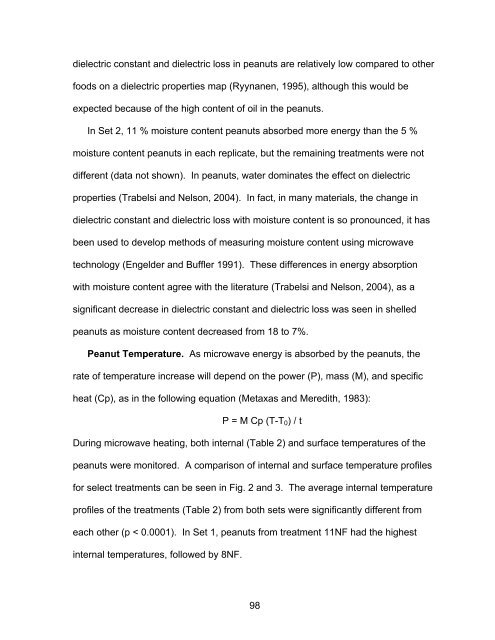Abstract SCHIRACK, ANDRIANA VAIS. The Effect of Microwave ...
Abstract SCHIRACK, ANDRIANA VAIS. The Effect of Microwave ...
Abstract SCHIRACK, ANDRIANA VAIS. The Effect of Microwave ...
You also want an ePaper? Increase the reach of your titles
YUMPU automatically turns print PDFs into web optimized ePapers that Google loves.
dielectric constant and dielectric loss in peanuts are relatively low compared to other<br />
foods on a dielectric properties map (Ryynanen, 1995), although this would be<br />
expected because <strong>of</strong> the high content <strong>of</strong> oil in the peanuts.<br />
In Set 2, 11 % moisture content peanuts absorbed more energy than the 5 %<br />
moisture content peanuts in each replicate, but the remaining treatments were not<br />
different (data not shown). In peanuts, water dominates the effect on dielectric<br />
properties (Trabelsi and Nelson, 2004). In fact, in many materials, the change in<br />
dielectric constant and dielectric loss with moisture content is so pronounced, it has<br />
been used to develop methods <strong>of</strong> measuring moisture content using microwave<br />
technology (Engelder and Buffler 1991). <strong>The</strong>se differences in energy absorption<br />
with moisture content agree with the literature (Trabelsi and Nelson, 2004), as a<br />
significant decrease in dielectric constant and dielectric loss was seen in shelled<br />
peanuts as moisture content decreased from 18 to 7%.<br />
Peanut Temperature. As microwave energy is absorbed by the peanuts, the<br />
rate <strong>of</strong> temperature increase will depend on the power (P), mass (M), and specific<br />
heat (Cp), as in the following equation (Metaxas and Meredith, 1983):<br />
P = M Cp (T-T0) / t<br />
During microwave heating, both internal (Table 2) and surface temperatures <strong>of</strong> the<br />
peanuts were monitored. A comparison <strong>of</strong> internal and surface temperature pr<strong>of</strong>iles<br />
for select treatments can be seen in Fig. 2 and 3. <strong>The</strong> average internal temperature<br />
pr<strong>of</strong>iles <strong>of</strong> the treatments (Table 2) from both sets were significantly different from<br />
each other (p < 0.0001). In Set 1, peanuts from treatment 11NF had the highest<br />
internal temperatures, followed by 8NF.<br />
98

















